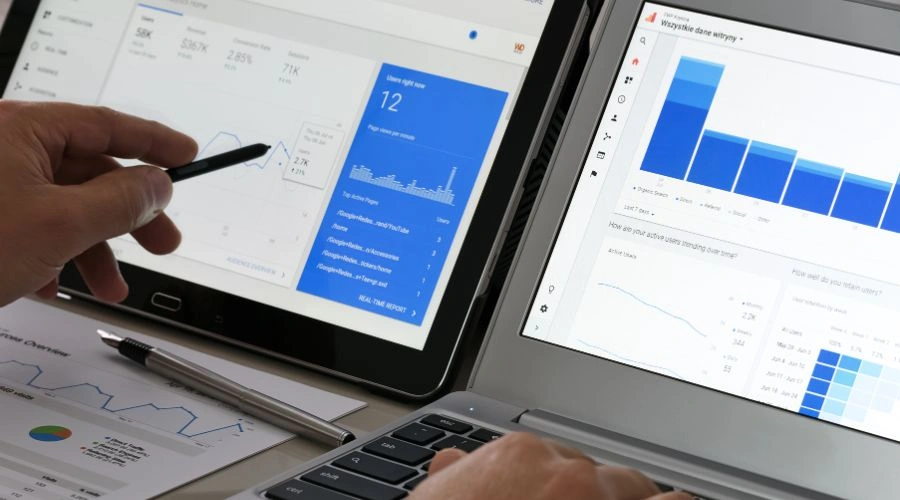Using GA 4 to Track Form Fills on Your Treatment Center Website
In the increasingly competitive field of substance abuse treatment and mental health services, success often falls on your ability to optimize your website’s performance to boost your lead conversion rates.
For any treatment facility, contact forms are critical, as they often allow future clients to take the initial steps toward treatment. Learning how these clients engage with specific form submission content is vital for connecting them with the proper services and fine-tuning marketing campaigns.
Continue reading the following article from the experts at Ads Up Marketing to learn the most efficient ways how to track form submission messages in Tag Manager as a part of Google’s suite of Analytics tools.
We provide priceless knowledge you can implement today to begin improving your form-tracking efforts and target the clients that best fit the criteria you’re looking for from your ideal demographic.
Why Does It Matter If You Track Form Submissions?

Form tracking begins after a successful submission, offering valuable client insight that can dictate your success as a substance abuse treatment facility. The industry offers multiple form submission templates, each providing a unique set of key metrics about future clients.
On your website, clients will likely encounter various form submission options, ranging from requests for basic information about your facility to verifying insurance coverage to applying for admission to your treatment center.
The primary reasons for form tracking include:
1. Measuring the Success of Your Marketing Efforts
When you track form submissions, you know precisely which marketing campaigns produce the most valuable results.
For example, if your Google Ads campaign that drives traffic to a landing page requires a form submission with basic information about potential clients, you can gauge the effectiveness of your campaign by analyzing successful form submission numbers.
2. Understanding How Website Visitors Behave
By leveraging form submission tracking, you can accurately determine which landing pages, blog content or CTAs yield the best price-per-conversion. This allows you to save precious marketing funds and restructure your website to increase engagement.
3. Measuring Your ROI
If you track form submissions, you can directly calculate your return on investment on ad spend. This includes measuring your price-per-conversion, as mentioned above, which is another way to describe the cost of acquiring each new client. However, it’s worth noting that a conversion doesn’t always have to be defined as a new client enrollment.
A conversion can be a form submission that successfully provides you with a potential client’s email or information about their insurance agency. When you control form tracking, defining the parameters that outline a successful conversion is up to you.
4. Boost Client Outreach
Form tracking methods improve multiple dynamics between your facility and future clients. For example, form submission tracking enhances the response times of your admissions department, allowing your representatives to cater to potential clients and ensure they receive a high degree of support. This also increases your chances of boosting your conversions.
When you accurately track a form submission action, you can improve your marketing efforts and create a more positive client experience.
The following section outlines setting up form submission campaigns using Google Tag Manager.
Set Up Form Submit Tracking With Google Tag Manager

Google Tag Manager makes it simple to track form actions by giving you the power to manipulate things like form submission trigger type, form variables, and different tags—all without using advanced coding.
It is worth noting that while GTM does simplify form tracking, not all form submissions trigger automatically. Many modern websites use AJAX-based forms, which don’t always trigger the built-in GTM Form Submission event.
A more reliable method is using Element Visibility triggers or Click Triggers for “Submit” buttons, and ensure accurate tracking, use additional methods like CSS selectors, Form ID targeting, and the Document Object Model (DOM) event listeners can prove useful.
Use the following steps to set up form submission tracking using your Google Tag Manager account:
1. Create a Form Submission Trigger
A form submission trigger alerts you that a specific type of form submission has taken place on your website. Treatment centers that rely on clients to perform some form submit action can leverage this process to create various triggers.
Google Tag Manager (GTM) simplifies tracking form submissions by enabling you to manage tags and triggers without extensive coding. Follow these steps to set up form tracking:
- Log into Google Tag Manager. If you haven’t already, create an account unique to your website.
- Navigate to the “Triggers” section. Click on “Triggers” in the left-hand menu and then “New.”
- Select Trigger Type. Choose the form submit trigger. This is simply known as “Form Submission in the selection box.
- Configure the Specifics:
- In this section, you’ll select whether to track all forms or specific forms like “Facility Inquiry” or “Verify Insurance”—or any other forms you’ve created to engage with clients.
2. Create a GA4 Event Tag
A GA4 Event Tag is a code that tracks a custom event on your website and sends the information to Google Analytics 4. These tags track things like a successful form submission but can also notify you when a success message is sent to a client.
It can also inform you when a client first visits a web page or track a page path from the submit button to the success page.
It’s up to you to configure the tag settings and create a unique command tag that describes the event, but, to clarify, GA4 tags can be set up without custom JavaScript in most cases.
- Navigate to Tags. Click “Tags” in the Google Tag Manager menu and select “New.”
- Choose Tag Type. Choose “Google Analytics: GA4 Event.”
- Configure the Tag:
- Choose the event name (“form_submit,” “first_page,” etc.). Include parameters like form_name or form_id to separate one form from the other.
- In the case of addiction rehabs, you can consider parameters like lead_type, admission_inquirty, and insurance_information.
- Link the Trigger to the Tag. Connect the tag to the form submission trigger you just created.
- Test and Publish. Test the tag in Preview mode to be sure it fires, then publish and save your changes.
- If forms do not trigger the submission event, consider using an Element Visibility Tag Trigger to detect when a success message appears.
3. Integrating Google Tag Manager with GA4
The final step is to ensure that Google Tag Manager has been correctly integrated with Google Analytics 4. After optimizing and configuring GTM, GA4 makes data analysis a powerful tool in your corner.
Now that your tag configuration, trigger configuration, form types, and trigger fires have been put through preview mode and successfully filled, create a GA4 property for your website. Simply log into GA4 and select “Events.” Create a custom event specifically for form submissions. Whatever event name you used in GTM, be sure it’s identical in Google Analytics.
Include relevant parameters that allow you to dig deeper, such as form_name, page_path, lead_type, and other hyper-descriptive labels. Use preview and debug mode to ensure your form interactions are working correctly. Don’t skip this step; we strongly encourage using preview and debug mode to eliminate potential errors.
Using Tracking Techniques to Your Advantage

After finalizing the technical work, you can review your website and ensure its cosmetic values match your overall theme. You can also edit the placements of submit buttons, colors, and fonts to your liking.
Believe it or not, uniformity is a large part of digital marketing, and even seemingly insignificant elements like color-matching can make a huge difference in your success.
When you’re sure each element appears the way you’d like, including element visibility, correct form classes, an optimized “thank you page,” and tested to ensure your forms don’t impact page load speeds, you can reflect on the best ways to leverage the power of your newly optimized tracking techniques using Google Analytics.
Listed below are just a few examples of the power of GTM and Google Analytics for form tracking:
1. Tracking Conversion Paths
You must understand the customer journey, also known as your rehab marketing funnel. Your built-in form variables, alerts when forms are submitted successfully, ensured thank you page firing correctly, and other elements of form success allow you to track your clients’ conversion paths. You can track the client experience from start to finish by analyzing form success via winning campaigns.
Using additional helpers like heat maps shows you the areas of the same page you’re tracking clients are attracted to. Use this data to your advantage and duplicate the process. However, it’s essential to test.
Obtain a large enough data set, as no two customer journeys are identical. The goal is to find and combine the most successful elements to create campaigns that produce stellar results.
2. Optimize Existing Content
Pages where you notice the most success message alerts and more enormous thank you page pop-ups will clue you into the content that engages your clients the most.
On the other hand, pages that lack consistency in these areas need to be reworked. Using your metrics and data on hand can help you identify existing content that may be optimized further to produce more favorable results.
3. Improve Element Visibility for Better Form Interactions
Another way to get the most out of GTM and Google Analytics is by using the data to help you improve the visibility of elements and the overall design of your forms.
But don’t let this limit you from forming element design alone. Use the same concepts to enhance your thank you page and other visual elements that play a massive role in the client’s journey on your website.
4. Make High-Value Leads a Priority

Leveraging all of the data compiled by GA4 gives you a clear view of who your most high-value leads are and where they spend the most time on your website. In addition, the information translated through the forms submitted can be very telling.
For example, a client who fills out admissions inquiry forms and insurance verification should be considered higher value than one who simply submits a request for more information through a simple email submission.
Use this information to identify these clients and reach out using retargeting campaigns or email swipe marketing.
5. Monitor Offline Conversions
Using your forms and page path layout, an effective marketing plan can generate phone calls. Enhanced measurement can track phone calls and submissions that lead directly to in-person interviews.
These tactics can help you drill down and gain deeper insight into the data collected by GA4.
Contact Ads Up Marketing to Help with Form Submission Efforts
At Ads Up Marketing, we have a team of experts with top-level knowledge of universal analytics who create new page elements and act as general guides to facility success.
After all, enhanced marketing is what we do best. We’re highly skilled in finding the best route to get your target demographic to your website and take the desired actions.
We can help in every aspect of your form submission/marketing campaigns, from creating and optimizing your accounts to crafting your strategy and analyzing the data to maximize conversions.
For more information, reach out to our team today!
Free Digital Marketing Analysis




